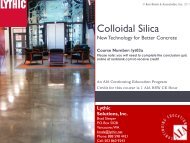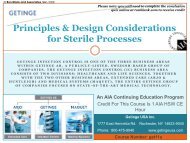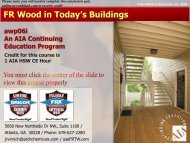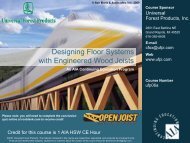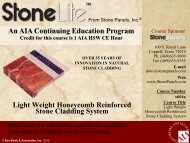Understanding the UL Fire Resistance Directories - Ron Blank ...
Understanding the UL Fire Resistance Directories - Ron Blank ...
Understanding the UL Fire Resistance Directories - Ron Blank ...
- No tags were found...
You also want an ePaper? Increase the reach of your titles
YUMPU automatically turns print PDFs into web optimized ePapers that Google loves.
An American Institute of Architects (AIA)Continuing Education Program<strong>Understanding</strong> <strong>UL</strong>Course Format: This is a structured, web-based, self study course with afinal exam.Course Credit: 1 Health Safety & Welfare (HSW) Learning Unit (LU)Completion Certificate: A confirmation is sent to you by email and you can printone upon successful completion of a course or from your <strong>Ron</strong><strong>Blank</strong>.comtranscript. If you have any difficulties printing or receiving your Certificate pleasesend requests to carol@ronblank.comDesign professionals, please remember to print or save your certificate ofcompletion after successfully completing a course conclusion quiz. Emailconfirmations will be sent to <strong>the</strong> email address you have provided in your<strong>Ron</strong><strong>Blank</strong>.com account.
<strong>Understanding</strong> <strong>UL</strong>Copyright MaterialsThis presentation is protected by US and International copyrightlaws. Reproduction, distribution, display and use of <strong>the</strong>presentation without written permission of© <strong>Ron</strong> <strong>Blank</strong> & Associates, Inc. 2007and© National Gypsum Company 2007is prohibited.
<strong>Understanding</strong> <strong>UL</strong>Learning ObjectivesUpon completion of this course <strong>the</strong> Design Professional will beable to:• Find <strong>UL</strong> designs on-line• Explain <strong>the</strong> difference between <strong>the</strong> three <strong>UL</strong> Volumes• Understand <strong>Fire</strong> Rated Assemblies• Explain how to use Volume 1• Explain how <strong>the</strong> first 10 pages of Volume 1 can help• List <strong>the</strong> fire resistant properties of gypsum• Define what gypsum calcination is• Analyze 3 <strong>UL</strong> designs• Discuss FAQ’s
<strong>Understanding</strong> <strong>UL</strong>Who is Underwriters Laboratories?• An independent, not-for-profit company• Perform product-safety t testingtiand certification• Over 100 years old (founded d in1894)• 17 billion <strong>UL</strong> marks appear on products• 64,482 manufacturers produce <strong>UL</strong>certified products• <strong>UL</strong> customers are found in 99 countries
<strong>Understanding</strong> <strong>UL</strong><strong>UL</strong> <strong>Fire</strong> <strong>Resistance</strong> <strong>Directories</strong>iAll volumes available on <strong>the</strong> <strong>UL</strong> website:• www.<strong>UL</strong>.com*• Download• Can be copied onto plans• “reprinted with permission...”. Page vii,paragraph 8<strong>UL</strong> wants architects and designers to cut, copy, andpaste directly from <strong>the</strong>ir web pages into <strong>the</strong>ir plans tobe sure that <strong>the</strong> project is specified correctly. Let’s lookat <strong>the</strong> <strong>UL</strong> web site…
<strong>UL</strong> Website<strong>Understanding</strong> <strong>UL</strong>
<strong>Understanding</strong> <strong>UL</strong><strong>UL</strong> <strong>Fire</strong> <strong>Resistance</strong> <strong>Directories</strong>i3 Volumes: Vol. 1Vol. 2AVol. 2BVol. 320062006 2006 2006
<strong>Understanding</strong> <strong>UL</strong>Volume 3:2006• Dampers• <strong>Fire</strong> Doors• Glazing Materials• Related Equipment
<strong>Understanding</strong> <strong>UL</strong>Volume 2A:• Joint Systems2006 • Through-Penetration<strong>Fire</strong>stop Systems• Electrical CircuitProtective Systems• Duct Assemblies
<strong>Understanding</strong> <strong>UL</strong>Volume 2B:• Joint Systems2006 • Through-Penetration<strong>Fire</strong>stop Systems• Electrical l CircuititProtective Systems• Duct Assemblies
<strong>Understanding</strong> <strong>UL</strong>Volume 1:• Beams• Floors• Roofs2006• Columns• Walls• Partitions
<strong>Understanding</strong> <strong>UL</strong><strong>Fire</strong> Rated Assemblies• Based on hourly ratings• Test standards:ASTM E119NFPA 251ASTM id th t d d tASTM provides <strong>the</strong> standards towhich <strong>UL</strong> tests assemblies.
<strong>Understanding</strong> <strong>UL</strong>Research & Testing FacilityASTM E 1192 things determine a successful fire test:Temperature (did not rise above <strong>the</strong> limit) it)Hose stream (no through penetration orwallboard failure to <strong>the</strong> o<strong>the</strong>r side)This may look like a failure but is actually apass. The temperature did not rise above<strong>the</strong> limit and <strong>the</strong> wall passed <strong>the</strong> hose test.As you can see, <strong>the</strong> wall did not fail with<strong>the</strong> hose stream test . There is not throughpenetration or wallboard failure to <strong>the</strong> o<strong>the</strong>rside.Buffalo, New York
<strong>Understanding</strong> <strong>UL</strong>ASTM E119 Standard d Time/Temperature CurveThis is <strong>the</strong> time temperature curve. This shows that at 5 minutes,<strong>the</strong> furnace reaches 1000 degrees and at 1 hour <strong>the</strong> furnacereaches 1700 degrees during <strong>the</strong> standard test.180016001700º F1 HR.At 5 minutes, furnacereaches 1000’F.At 1 hour, furnacereaches 1700’F.14001200100080060040020001000º F5 Min0 1 2 3
<strong>Understanding</strong> <strong>UL</strong>Test Requirements, ASTM E119• Average of all <strong>the</strong>rmocouples must not exceed250°F over ambient temperature• No single <strong>the</strong>rmocouple can exceed 325°F overambient temperature• Structure can’t show evidence of burn through• Structure must not collapse
<strong>Understanding</strong> <strong>UL</strong>Finish i Rating vs. <strong>Fire</strong> Rating• <strong>Fire</strong> Ratings pertain to a total ASSEMBLY.• Finish Rating is <strong>the</strong> time required to obtain anaverage temperature rise of 250 degrees (or asingle point rise of 325 degrees) between <strong>the</strong>material being tested (gypsum board) and <strong>the</strong>substrate being protected (i.e. plywood).
<strong>Understanding</strong> <strong>UL</strong>Volume 1• First 10 pages (mostimportant)• Table on page 12006• We will now start to takeWe will now start to takea closer look at how tonavigate and use thisbook
<strong>Understanding</strong> <strong>UL</strong>Important t Key Passages• Pg 2 - Nails vs. screws• Pg 3 - Gypsum board orientation• Pg 3 - Gypsum board joint treatment (fire taping)• Pg 4 - Metal thickness (steel joists)• Pg 5 - Gypsum board• Pg 8 - <strong>Blank</strong>et insulation• Pg 10 - Wall and Partition Assemblies
<strong>Understanding</strong> <strong>UL</strong>Page 2 – Nails vs. Screws5. Nails and ScrewsNails are specified according to ASTM F547 or ASTMC514. Nails used to attach gypsum board to woodframing shall be cement coated box nails or cementcoated cooler nails unless specified o<strong>the</strong>rwise in <strong>the</strong>specific designs. Screws meeting ASTM C1002 orASTM C954 may be substituted for nails, one forone, when <strong>the</strong> head diameter, length, and spacingequal or exceed <strong>the</strong> requirements for <strong>the</strong> specifiednails.
Page 3 – Gypsum Board Orientationti<strong>Understanding</strong> <strong>UL</strong>10. Gypsum Board OrientationVertically applied gypsum board is gypsum board thatis applied with <strong>the</strong> long edges parallel to <strong>the</strong> framingmembers to which it is attached. Horizontally appliedgypsum board applied is gypsum board applied with<strong>the</strong> long edges perpendicular to <strong>the</strong> framingmembers to which it is attached.
<strong>Understanding</strong> <strong>UL</strong>Pg 3 – Gypsum Board Joint Treatment t (fire taping)11. Gypsum Board Joint Treatment (<strong>Fire</strong> Taping)Unless o<strong>the</strong>rwise specified in <strong>the</strong> specific design allgypsum board systems except those with predecoratedor metal covered surfaces have joints tapedand joints and fastener heads covered with onecoat of joint compound (fire taped). Base layers inmulti layer systems are not required to have joints orfastener heads taped or covered with joint compound.
<strong>Understanding</strong> <strong>UL</strong>Page 4 – Metal Thickness (steel Joists)7. Steel JoistsThe specified minimum size joist in floor- or roof-ceiling designs is <strong>the</strong>joist that meets <strong>the</strong> requirements for both <strong>the</strong> minimum depth and <strong>the</strong>minimum weight per foot. Joists that exceed <strong>the</strong> specified minimumsize may be used, provided <strong>the</strong> accessories are compatible. Thedimension from <strong>the</strong> bottom chord of joists to <strong>the</strong> ceiling, whe<strong>the</strong>r given orcalculated, is a minimum.Spacing between joists may be increased from that specified to amaximum of 4 ft on centers if <strong>the</strong> floor slab meets structural t requirementsand <strong>the</strong> spacing of <strong>the</strong> hanger wires supporting <strong>the</strong> ceiling is notincreased. Where it is necessary to provide support for <strong>the</strong> ceiling hangerwires between <strong>the</strong> joists, this may be accomplished by using 1-1/21/2 in., No.16 gauge or larger cold-rolled steel channels. Each channel with its weboriented vertically should be placed on top of and perpendicular to <strong>the</strong>joist's bottom chord and tied <strong>the</strong>reto with a double strand of No. 18 SWGgalvanized steel wire.
<strong>Understanding</strong> <strong>UL</strong>Page 5 – Gypsum Board9. Gypsum BoardGypsum board thicknesses specified in specific designs areminimums. Greater thicknesses of gypsum board are permitted aslong as <strong>the</strong> fastener length is increased to provide penetrationinto framing that is equal to or greater than that achieved with <strong>the</strong>specified gypsum board thickness and fasteners.Additional layers of gypsum board are permitted to be added to anydesign.For designs containing <strong>the</strong> statement "See Gypsum Board (CKNX)Category for names of Classified Companies," any product in <strong>the</strong>category (CKNX) that meets <strong>the</strong> specifications (i.e., thickness,size) described in <strong>the</strong> design may be used. This statement isapplicable to any gypsum board manufacturer who producesClassified gypsum board meeting <strong>the</strong> thickness and size of <strong>the</strong> boardspecified in <strong>the</strong> design. It is not required that <strong>the</strong>se Design Numbersappear in <strong>the</strong> individual Classifications.
<strong>Understanding</strong> <strong>UL</strong>Page 8 – <strong>Blank</strong>et Insulation18. <strong>Blank</strong>et InsulationUnless specifically described in a design, <strong>the</strong> additionof insulation in <strong>the</strong> concealed space between <strong>the</strong>ceiling membrane and <strong>the</strong> floor or roof structuremay reduce <strong>the</strong> hourly rating of an assembly bycausing premature disruption of <strong>the</strong> ceilingmembrane and/or higher temperatures on structuralcomponents under fire exposure conditions.
Page 10 – Wall and Partition Assemblies<strong>Understanding</strong> <strong>UL</strong>• The ratings for walls and partitions apply when ei<strong>the</strong>r face of <strong>the</strong>assembly is exposed to <strong>the</strong> fire unless indicated o<strong>the</strong>rwise on aspecific Design.• The hourly rating of a load bearing assembly also applies to <strong>the</strong> sameassembly when it is used as a non-load bearing assembly.• The size of studs are minimum unless o<strong>the</strong>rwise stated in a Design.• The spacing of studs is a maximum unless o<strong>the</strong>rwise stated in aDesign.• Spacing between een parallel rows of studs are minimums ms unlesso<strong>the</strong>rwise stated in <strong>the</strong> individual designs.• Gypsum board thicknesses specified in specific designs areminimums. i Greater thicknesses of gypsum board are permitted aslong as <strong>the</strong> fastener length is increased to provide penetrationinto framing that is equal to or greater than that achieved with <strong>the</strong>specified gypsum board thickness and fasteners.
Page 10 – Wall and Partition Assemblies<strong>Understanding</strong> <strong>UL</strong>• Additional layers of gypsum board are permitted to be added to any design.• Orientation, vertical or horizontal, of <strong>the</strong> application of gypsum board inwalls and partitions is specified in <strong>the</strong> individual design.• Except when gypsum board is allowed to be applied horizontally in <strong>the</strong> individualwall designs, horizontal butt joints of vertically applied gypsum board should bebacked by <strong>the</strong> same type studs as specified in <strong>the</strong> design. Alternatively,minimum i 25 gauge steel framing with a minimum i attachment t face of 1 1/4"may be used for <strong>the</strong> backing. Both edges of <strong>the</strong> gypsum board forming <strong>the</strong>horizontal joint shall be attached to <strong>the</strong> backing with <strong>the</strong> same screws andspacing as specified in <strong>the</strong> design for <strong>the</strong> attachment of <strong>the</strong> gypsum board edges,<strong>the</strong>n finished as specified for <strong>the</strong> vertical joints.• Horizontal butt joints on opposite sides of <strong>the</strong> studs in single-layerapplications should be staggered a minimum of 12 inches unless o<strong>the</strong>rwisestated in <strong>the</strong> individual designs. Horizontal butt joints in adjacent layers on <strong>the</strong>same face of <strong>the</strong> assembly in multiple-layer applications should be staggered aminimum of 12 inches unless o<strong>the</strong>rwise stated in <strong>the</strong> individual designs.
Page 10 – Wall and Partition Assemblies<strong>Understanding</strong> <strong>UL</strong>1. Wood Stud Walls• The fire stopping requirements for wood stud assemblies is to bedetermined from <strong>the</strong> Authorities Having Jurisdiction. Horizontalbridging is included in most fire test samples in order to fully load<strong>the</strong> wood studs. This horizontal bridging should not beconsidered d as a means of fire stopping.• The hourly fire ratings for load bearing wood stud walls werederived with a superimposed p load applied to <strong>the</strong> wall assemblyintended to <strong>the</strong>oretically develop maximum working stresses notexceeding <strong>the</strong> design values published in <strong>the</strong> Supplement to <strong>the</strong>1991 Edition of <strong>the</strong> National Design Specification for woodconstruction. In addition, <strong>the</strong> design load per square inch ofcross sectional area for any wood stud shall not exceed 385 psi.• Wood stud walls may contain fire retardant t treated t studs as wellas untreated wood studs.
Page 10 – Wall and Partition Assemblies<strong>Understanding</strong> <strong>UL</strong>2. Steel Studs• The dimensions and gauge of steel studs are minimums.The hourly ratings apply when <strong>the</strong> steel studs are of a heaviergauge and/or larger dimensions than specified in a Design. Thesuperimposed load of bearings walls utilizing steel studs shall bebased on <strong>the</strong> capacity of <strong>the</strong> studs as determined d by <strong>the</strong> 1986edition of <strong>the</strong> AISI Specification for <strong>the</strong> Design of Cold FormedSteel Structural Members with <strong>the</strong> December 11, 1989Addendum.
Numbering System for <strong>Fire</strong>-RatedAssemblies<strong>Understanding</strong> <strong>UL</strong>
<strong>Understanding</strong> <strong>UL</strong>Numbering System for <strong>Fire</strong> Rated AssembliesType of Protection: Membrane ProtectionNext, you look at <strong>the</strong> protection you will000-099put over <strong>the</strong> structural element or groupof construction. The first option is 100-199Membrane Protection. This is protection200-299that is put on top of or mechanicallyfastened to <strong>the</strong> structural element much300-399399like drywall is fastened to steel studs.Examples are concealed grid or exposed400-499grid systems, gypsum, metal lath and or500-599599plaster. These numbers fall between 000and 599.
<strong>Understanding</strong> <strong>UL</strong>Numbering System for <strong>Fire</strong> Rated AssembliesType of Protection: Direct Applied Protection600-699700-899Your next option is Direct Applied Protection. Direct Applied isnot fastened to but sprayed on such as mastic coating orSFRM. These design numbers fall between 600-899.
<strong>Understanding</strong> <strong>UL</strong>Numbering System for <strong>Fire</strong> Rated AssembliesType of Protection: Unprotected900-999Finally, <strong>the</strong>re is Unprotected. Unprotected is not fastened likey, p pmembrane protection or sprayed on like Direct Applied but isprotected using masonry or brick block. These designs will fallbetween 900-999.
<strong>Fire</strong> Resistive Properties of Gypsum<strong>Understanding</strong> <strong>UL</strong>• Gypsum is approximately 21% by weight chemicallycombined water.• This greatly contributes to its effectiveness as a fireresistive barrier.• Calcination is a process in which a material is heatedto a temperature below its melting point to effect a<strong>the</strong>rmal decomposition or a phase transition o<strong>the</strong>rthan melting.
<strong>Fire</strong> Resistive Properties of Gypsum<strong>Understanding</strong> <strong>UL</strong>• Gypsum-protected wood or steel structural members areexposed to fire.• Water in board is released as steam and acts as a<strong>the</strong>rmal barrier until calcination is completed.• Temperature directly behind <strong>the</strong> plane of calcination isonly slightly hotter than that of boiling water which issignificantly lower than <strong>the</strong> temperature at which steelbegins losing strength or wood ignites.
<strong>Understanding</strong> <strong>UL</strong>Types of Drywall/Gypsum Board• “Regular”• Type “X”• Type “C”
<strong>Understanding</strong> <strong>UL</strong>Regular Gypsum Board• All gypsum board affords a degree of natural fireresistance. The fire resistant noncombustible core iscomposed mainly of gypsum.
<strong>Understanding</strong> <strong>UL</strong>Type “X” Core• “eXtra” fire resistance• The basic components added that give Type “X” it’ssuperior fire resistant core are gypsum andfiberglass.
<strong>Understanding</strong> <strong>UL</strong>Type “C” Core• Has superior fire resistance over Type “X”.• Type “C” core is proprietary, so <strong>the</strong> enhancingingredients vary by manufacturer.
How do I know what type ofgypsum board is being installed?
<strong>Understanding</strong> <strong>UL</strong><strong>UL</strong> Label Sample: Type XUNDERWRITERS LABORATORIES INC. ®CLASSIFIEDR 3501 WALLBOARD GYPSUMISSUE NO. C-32585/8” (24 OR 46 TO 54 IN. WIDE)TYPEFSWThis is what a <strong>UL</strong>label looks likewhen printed on<strong>the</strong> back ofwallboard. TheFSW designatesthis is type Xwallboard.FIRE RESISTANCE CLASSIFICATIONSEE <strong>UL</strong> FIRE RESISTANCE DIRECTORYFSW:<strong>Fire</strong>-ShieldHi-Abuse XP <strong>Fire</strong>-Shield<strong>Fire</strong>-Shield Exterior Soffit Board<strong>Fire</strong>-Shield Shaftliner<strong>Fire</strong>-Shield Shaftliner XP
<strong>Understanding</strong> <strong>UL</strong><strong>UL</strong> Label Sample: Type CUNDERWRITERS LABORATORIES INC. ®CLASSIFIEDR 3501 WALLBOARD GYPSUMTYPEFSW-CISSUE NO. C-32585/8” (24 OR 46 TO 54 IN. WIDE)FIRE RESISTANCE CLASSIFICATIONSEE <strong>UL</strong> FIRE RESISTANCE DIRECTORYThis is a <strong>UL</strong> label for type C. The FSW-C designates type C.FSW-C:<strong>Fire</strong>-Shield C
<strong>Understanding</strong> <strong>UL</strong><strong>UL</strong> Directory – Guide InfoTo determine whichproducts areincluded in <strong>the</strong>assemblies in <strong>the</strong> <strong>UL</strong>Directory, check out“CKNX.Guide-InfoGypsum Board”.Click on “ViewListings” to see <strong>the</strong>companies included.
<strong>Understanding</strong> <strong>UL</strong><strong>UL</strong> Directory - ManufacturersYou’ll findlistings for 23manufacturersof gypsumwallboard.
<strong>Understanding</strong> <strong>UL</strong><strong>UL</strong> Directory - ProductsHere, you’llfind a list of allboard productsorganized by:• Thickness• Board width• Core typeEveryassemblyusing thatproduct ishyperlinked.
Let’s find an assembly for metalstuds and gypsum board, 1HR.
NUMBERING SYSTEM FOR FIRE RATED ASSEMBLIESTYPES OF PROTECTIONMembrane ProtectionNumbering System for <strong>Fire</strong> RatedAssemblies – Types of Protection<strong>Understanding</strong> <strong>UL</strong>Direct AppliedProtectionUnprotectedGroups of Construction 000-099 100-199 200-299 300-399 400-499 500-599 600-699 700-899 900-999Floors-Ceilings A,B*,or C*Concrete and CellularSteel FloorD, E*orF*Concrete and Steel FloorUnitsG, H*, or I*Concrete and Steel JoistsConcealedGrid Sys.ConcealedGrid Sys.ConcealedGrid Sys.(Reserved)(Reserved)(Reserved)Exposed GridSystemExposed GridSystemExposed GridSystem(Reserved)(Reserved)(Reserved)Metal LathMetal LathMetal LathGypsumBoardGypsumBoardGypsumBoardMisc. SFRM + UnprotectedMasticCoatingSFRM +UnprotectedMisc. SFRM + UnprotectedJ or KConcreteConcealedGrid Sys.(Reserved)Exposed GridSystem(Reserved)Metal LathGypsumBoardMisc. SFRM + UnprotectedL or M* Wood Joist orCombination Wood andSteel AssembliesBeams:N or O* for Floor-CeilingRoof-Ceiling:P, Q* or R*Beams:S or T* Roof-CeilingWall & Partition:U, V or W*Columns: X, Y or Z*ConcealedExposed GridGypsum(Reserved)(Reserved) Metal LathGrid Sys. System BoardConcealedGrid Sys.ConcealedGrid Sys.BuildingUnits(Reserved)(Reserved)(Reserved)Bldg. orPartition (Reserved)Panel UnitsBuildingUnitsPrefabricatedExposed GridSystemExposed GridSystemExposed GridSystemInsulatingConcrete(Reserved)Batts &<strong>Blank</strong>ets orMineral andFiber Boards(Reserved)(Reserved)Metal LathMetal LathMetal LathGypsumBoardGypsumBoardGypsumBoardMisc. SFRM + UnprotectedMasticCoating SFRM + UnprotectedMisc.MasticCoatingWood StudMetal StudMetal PanelsGypsum Bd. Gypsum Bd.Gypsum Bd.Misc.Lath and/or Lath and/orLath and/orPlaster PlasterPlasterBatts &<strong>Blank</strong>ets or Metal Lath & Gypsum MasticMineral & Plaster Board CoatingFiber BoardsSFRM +SFRM +SFRM +SFRM +UnprotectedUnprotectedMasonryReserved)The prefix numbers with an asterisk (*) and <strong>the</strong> design numbers indicated as "Reserved" in <strong>the</strong>above table are for future expansion and to cater to new types of systems
<strong>Understanding</strong> <strong>UL</strong>ASSEMBLY U465• Wall & Partition:U, V or W*• 400 – 499• Metal Stud, Gypsum Board, Lath&/or Plaster• Assembly U465
<strong>Understanding</strong> <strong>UL</strong>Design No. U465Nonbearing Wall Rating – 1HRHR.1. Floor and Ceiling Runners (Not shown)2. Steel Studs3. Batts and <strong>Blank</strong>ets*4. Gypsum Board5. Joint Tape and Compound6. Resilient Channel
<strong>Understanding</strong> <strong>UL</strong>Design No. U465 continued1. Floor and Ceiling RunnersChannel shaped runners, 3 5/8 in wide, 1 ¼ in legs, formed frommin No 25 MSG galv steel, attached to floor and ceiling withfasteners spaced d24i in OC max2. Steel StudsChannel shaped, 3 5/8 in wide (min), 1 ¼ in legs, 3/8 in folded backreturns, formed from min No 25 MSG galv steel spaced 24 in OCmax.3 B tt dBl k t3. Batts and <strong>Blank</strong>etsMineral wool or glass fiber batts partially or completely filling studcavity.
<strong>Understanding</strong> <strong>UL</strong>Design No. U465 Continued4. Gypsum Board* - 5/8 in. thick, 4 ft wide, attached to steelstuds and floor and ceiling track with 1 in. long, Type S steelscrews spaced 8 in. OC. along edges of board and 12 in. OCin <strong>the</strong> field of <strong>the</strong> board. Joints oriented vertically andstaggered on opposite sides of <strong>the</strong> assembly. When attachedto item 6 (resilient channels) or 6A (furring channels),wallboard is screw attached to furring channels with 1 in.long, Type S steel screws spaced 12 in. OC. When used inwidths o<strong>the</strong>r than 48 in., gypsum panels to be installedhorizontally.
<strong>Understanding</strong> <strong>UL</strong>Design No. U465 Continued5. Joint Tape and Compound — Vinyl, dry or premixed joint compound,applied in two coats to joints and screw heads; paper p tape, 2 in. wide,embedded in first layer of compound over all joints. As an alternate, nominal3/32 in. thick gypsum veneer plaster may be applied to <strong>the</strong> entire surface ofClassified veneer baseboard. Joints reinforced. Paper tape and jointcompound may be omitted when gypsum boards are supplied with squareedges.6. Resilient Channel — (Optional-Not Shown) — 25 MSG galv steel resilientchannels spaced vertically max 24 in. OC, flange portion attached to eachintersecting stud with 1/2 in. long type S-12 panhead steel screws.6A Steel Framing Members (Not Shown)* As an alternate to Item 3 furring6A. Steel Framing Members (Not Shown)* — As an alternate to Item 3, furringchannels and resilient sound isolation clip as described below:a. Furring Channels
<strong>Understanding</strong> <strong>UL</strong>Specialty gypsum core types that can be used inU465 in lieu of standard 5/8” Type “X”Gypsum Company’s Core TypeFSKType “X” Plaster Board (Blue Board)FSK-CType “C” Plaster Board (Blue Board)FSK - GType “G” Plaster Board (Blue Board) – Not tAvailableFSW-CType “C”FSWFSW-3FSW-5Type “X”, Abuse Resistant Type “X”, Type “X” Exterior SoffitBoard, 1” Type “X” Shaftliner, 1” Type “X” Shaftliner mold resType “X” Mold Resistant, Type “X” Moisture Resistant, Type “X”Jumbo SheathingType “X” Impact Resistant Gypsum Board
Let’s find an assembly for metalstuds and gypsum board, 2HR.
NUMBERING SYSTEM FOR FIRE RATED ASSEMBLIESTYPES OF PROTECTIONMembrane Protection<strong>Understanding</strong> <strong>UL</strong>Direct AppliedProtectionUnprotectedGroups of Construction 000-099 100-199 200-299 300-399 400-499 500-599 600-699 700-899 900-999Floors-Ceilings A,B*,or C*Concrete and CellularSteel FloorD, E*orF*Concrete and Steel FloorUnitsG, H*, or I*Concrete and Steel JoistsConcealedGrid Sys.ConcealedGrid Sys.ConcealedGrid Sys.(Reserved)(Reserved)(Reserved)Exposed GridSystemExposed GridSystemExposed GridSystem(Reserved)(Reserved)(Reserved)Metal LathMetal LathMetal LathGypsumBoardGypsumBoardGypsumBoardMisc. SFRM + UnprotectedMasticCoatingSFRM +UnprotectedMisc. SFRM + UnprotectedJ or KConcreteConcealedGrid Sys.(Reserved)Exposed GridSystem(Reserved)Metal LathGypsumBoardMisc. SFRM + UnprotectedL or M* Wood Joist orCombination Wood andSteel AssembliesBeams:N or O* for Floor-CeilingRoof-Ceiling:P, Q* or R*Beams:S or T* Roof-CeilingWall & Partition:U, V or W*Columns: X, Y or Z*ConcealedExposed GridGypsum(Reserved)(Reserved) Metal LathGrid Sys. System BoardBatts &ConcealedExposed GridNumbering (Reserved)Grid Sys. System <strong>Blank</strong>ets orGypsumSystem for MetalMineral and <strong>Fire</strong> LathBoard RatedFiber BoardsAssembliesConcealedExposed GridGrid Sys.BuildingUnits(Reserved)(Reserved)SystemExposed GridSystem(Reserved)(Reserved)Metal LathMetal LathGypsumBoardGypsumBoardMisc. SFRM + UnprotectedMasticCoating SFRM + UnprotectedMisc.MasticCoatingBldg. or Wood StudMetal StudMetal PanelsPartitionInsulating Gypsum Bd. Gypsum Bd.Gypsum Bd.(Reserved)Misc.PanelConcrete Lath and/or Lath and/orLath and/orUnitsPlaster PlasterPlasterBatts &BuildingUnitsPrefabricated(Reserved)<strong>Blank</strong>ets or Metal Lath & Gypsum MasticMineral & Plaster Board CoatingFiber BoardsSFRM +SFRM +SFRM +SFRM +UnprotectedUnprotectedMasonryReserved)The prefix numbers with an asterisk (*) and <strong>the</strong> design numbers indicated as "Reserved" in <strong>the</strong>above table are for future expansion and to cater to new types of systems
<strong>Understanding</strong> <strong>UL</strong>ASSEMBLY U411• Wall & Partition:U, V or W*• 400 – 499• Metal Stud, Gypsum Board, Lath&/or Plaster• Assembly U411
<strong>Understanding</strong> <strong>UL</strong><strong>UL</strong> Design U411 – Nonbearing Wall Rating (2 HR.)2. 3. 4.1. Floor and Ceiling Runner (Not Shown)2. Steel Studs3. Batts and <strong>Blank</strong>ets*4. Gypsum Board*
<strong>Understanding</strong> <strong>UL</strong><strong>UL</strong> Design U4111. Floor & Ceiling Runners –Min 25 MSG galv steel 1 inch high, return legs 2- ½inin.wide (min), attached to floor and ceiling with fasteners.2. Steel Studs – Min 2-1/2 in. wide, 1-1/4 in. legs, 3/8 in.return, formed of min 25 MSG galv max stud spacing 24in. OC. Studs to be cut ¾ in. less than assembly height.
<strong>Understanding</strong> <strong>UL</strong><strong>UL</strong> Design U4113. Batts & <strong>Blank</strong>ets-Mineral wool or glass fiber batts partially or completelyfilling stud cavity. Fasten each batt to wallboard base layerwith a min 9/16 in. long staple. Use five staples for each 4ft. piece. Drive one staple in <strong>the</strong> center of each piece anda staple at Each corner, approx. 3 in. from edge.* See Batts & <strong>Blank</strong>ets category for names of manufacturers.
<strong>Understanding</strong> <strong>UL</strong><strong>UL</strong> Design U4114. Gypsum Board – 5/8 in. thick, outer layer paper or vinylsurfaced. (Laminated System) Wallboard appliedvertically in two layers. Inner layer attached to studs with1 in long Type S steel screws spaced 8 in OC alongvertical edges, and 12 in. OC in <strong>the</strong> field and outer layerlaminated to inner layer with joint compound, appliedwith notched spreader producing continuous beads ofcompound about 3/8 in in diameter, spaced not greaterthan 2 in OC.
Types of Gypsum Board used in U411<strong>Understanding</strong> <strong>UL</strong>Gypsum Company’s Core TypeFSK - CType “C” Plaster Board (Blue Board)FSK - G Type “G” Plaster Board (Blue Board) – Not AvailableFSW-C Type “C”FSMR-C Type “C” Mold Resistant, Type “C” Moisture ResistantFSWFSW-3FSW-5Type “X”, Abuse Resistant Type “X”, Type “X” Exterior SoffitBoard, 1” Type “X” Shaftliner, 1” Type “X” Shaftliner moldresistantType “X” Mold Resistant, Type “X” Moisture Resistant, Type “X”Jumbo SheathingType “X” Impact Resistant Gypsum Board
Let’s find an assembly for a Roof-Ceiling system with gypsum wallboard.
NUMBERING SYSTEM FOR FIRE RATED ASSEMBLIESTYPES OF PROTECTIONMembrane ProtectionNumbering System for <strong>Fire</strong> RatedAssemblies<strong>Understanding</strong> <strong>UL</strong>Direct AppliedProtectionUnprotectedGroups of Construction 000-099 100-199 200-299 300-399 400-499 500-599 600-699 700-899 900-999Floors-Ceilings A,B*,or C*Concrete and CellularSteel FloorD, E*orF*Concrete and Steel FloorUnitsG, H*, or I*Concrete and Steel JoistsConcealedGrid Sys.ConcealedGrid Sys.ConcealedGrid Sys.(Reserved)(Reserved)(Reserved)Exposed GridSystemExposed GridSystemExposed GridSystem(Reserved)(Reserved)(Reserved)Metal LathMetal LathMetal LathGypsumBoardGypsumBoardGypsumBoardMisc. SFRM + UnprotectedMasticCoatingSFRM +UnprotectedMisc. SFRM + UnprotectedJ or KConcreteConcealedGrid Sys.(Reserved)Exposed GridSystem(Reserved)Metal LathGypsumBoardMisc. SFRM + UnprotectedL or M* Wood Joist orCombination Wood andSteel AssembliesBeams:N or O* for Floor-CeilingRoof-Ceiling:P, Q* or R*Beams:S or T* Roof-CeilingWall & Partition:U, V or W*Columns: X, Y or Z*ConcealedExposed GridGypsum(Reserved)(Reserved) Metal LathGrid Sys. System BoardConcealedGrid Sys.ConcealedGrid Sys.BuildingUnits(Reserved)(Reserved)(Reserved)Bldg. orPartition (Reserved)Panel UnitsBuildingUnitsPrefabricatedExposed GridSystemExposed GridSystemExposed GridSystemInsulatingConcrete(Reserved)Batts &<strong>Blank</strong>ets orMineral andFiber Boards(Reserved)(Reserved)Metal LathMetal LathMetal LathGypsumBoardGypsumBoardGypsumBoardMisc. SFRM + UnprotectedMasticCoating SFRM + UnprotectedMisc.MasticCoatingWood StudMetal StudMetal PanelsGypsum Bd. Gypsum Bd.Gypsum Bd.Misc.Lath and/or Lath and/orLath and/orPlaster PlasterPlasterBatts &<strong>Blank</strong>ets or Metal Lath & Gypsum MasticMineral & Plaster Board CoatingFiber BoardsSFRM +SFRM +SFRM +SFRM +UnprotectedUnprotectedMasonryReserved)The prefix numbers with an asterisk (*) and <strong>the</strong> design numbers indicated as "Reserved" in <strong>the</strong>above table are for future expansion and to cater to new types of systems
<strong>Understanding</strong> <strong>UL</strong><strong>UL</strong> Design P533• Roof-Ceiling:P, ,Q* or R*• 500-599599• Gypsum Board• Assembly P533
<strong>Understanding</strong> <strong>UL</strong><strong>UL</strong> Design P533Design No. P533Unrestrained Assembly Rating- 1 HR.Finish Rating - 23 Min.
<strong>Understanding</strong> <strong>UL</strong><strong>UL</strong> Design P5331. Roofing System2. Trusses3. Batts and <strong>Blank</strong>ets*3A. Loose Fill Material*4. Air Duct*5. Ceiling Damper*6. Furring Channels7. Gypsum Board* - Nom 5/8 in. thick, 48in. wide, installed with long dimensionperpendicular to resilient channels with 1-1/8 in.long Type S screws spaced 12 in. OC and locateda min of 1/2 in. from side joints and 3 in. from <strong>the</strong>end joints. At end joints, two resilient channels areused, extending a min of 6 in. beyond both ends of<strong>the</strong> joint. When insulation, Item 3 or 3A, is drapedover <strong>the</strong> resilient channel/gypsum wallboard ceilingmembrane, screws shall be installed at 8 in. OC.8. Finishing System
<strong>Understanding</strong> <strong>UL</strong>Additional types of gypsum board used in P533Gypsum Core TypesFSW-CType “C”FSW-GFSK-CFSK-GType “G” – Not AvailableType “C” Plaster Board (Blue Board)Type “G” Plaster Board (Blue Board) – Not Available
Frequently Asked Questions
<strong>Understanding</strong> <strong>UL</strong>What does it mean to say that a particular wall orceiling system has achieved a 1-hour fire rating?Q.What does it mean to say that a particular wallor ceiling system has achieved a 1-hour firerating?A.It passes ASTM E119 for at least 60 minutes.
<strong>Understanding</strong> <strong>UL</strong>When constructing a fire-rated wallboard partition, must <strong>the</strong> exactstud size specified in <strong>the</strong> tested t design be utilized?Q.When constructing a fire-rated wallboardpartition, must <strong>the</strong> exact stud size specified in<strong>the</strong> tested design be utilized?A.Specified wood or steel stud sizes areminimums unless o<strong>the</strong>rwise stated in <strong>the</strong>design.
<strong>Understanding</strong> <strong>UL</strong>My fire rated design was tested with nails. Can Ifasten <strong>the</strong> wallboard with screws ra<strong>the</strong>r than nails?Q.My fire rated design was tested with nails. Can Ifasten <strong>the</strong> wallboard with screws ra<strong>the</strong>r than nails?A.Yes, screws can be used as an alternate to nails inwallboard designs.They must be substituted one-for-one when <strong>the</strong>head diameter, length and spacing equal orexceed <strong>the</strong> requirements for <strong>the</strong> specified nails.
<strong>Understanding</strong> <strong>UL</strong>Can I add glass fiber insulation to a fire rated partition design when it is notspecified as a component?Q.Can I add glass fiber insulation to a fire rated partitiondesign when it is not specified as a component?A.Yes, ,glass fiber insulation of a thickness not exceeding <strong>the</strong>depth of <strong>the</strong> stud is OK to add to <strong>the</strong> wall stud cavity.Yes for 1 hour rated G500 L500 and P500 series floorYes, for 1-hour rated G500, L500 and P500 series floorceilingassemblies, fiberglass insulation may be added to<strong>the</strong> plenum or joist space above <strong>the</strong> gypsum wallboardprovided an additional layer of gypsum wallboard is addedto <strong>the</strong> assembly.
<strong>Understanding</strong> <strong>UL</strong>What is <strong>the</strong> difference between “Regular” and Type“X” gypsum wallboard?Q.What is <strong>the</strong> difference between “Regular” and Type “X”gypsum wallboard?A.“eXtra” ”fire resistanttType “X” wallboard, which is typically required toachieve fire resistance ratings, is formulated by addingnoncombustible fibers to <strong>the</strong> gypsum.These fibers help maintain <strong>the</strong> integrity of <strong>the</strong> core asshrinkage occurs, providing greater resistance to heattransfer during fire exposure.
<strong>Understanding</strong> <strong>UL</strong>What is <strong>the</strong> fire rating for 5/8” Type “X” Wallboard?Q.What is <strong>the</strong> fire rating for 5/8” Type “X” Wallboard?A.5/8" Type “X” Wallboard has no fire rating.<strong>Fire</strong> ratings are assigned to a complete assembly thatmay include 5/8" Type “X” wallboard as a component.
<strong>Understanding</strong> <strong>UL</strong>Things to Remember• First 10 pages• Numbering on table• Assemblies• U 465• U 411• P 533
<strong>Understanding</strong> <strong>UL</strong>Learning ObjectivesThe Design Professional will now be able to:• Find <strong>UL</strong> designs on-line• Explain <strong>the</strong> difference between <strong>the</strong> three <strong>UL</strong> Volumes• Understand <strong>Fire</strong> Rated Assemblies• Explain how to use Volume 1• Explain how <strong>the</strong> first 10 pages of Volume 1 can help• List <strong>the</strong> fire resistant properties of gypsum• Define what gypsum calcination is• Analyze 3 <strong>UL</strong> designs• Discuss FAQ’s
<strong>Understanding</strong> <strong>the</strong> <strong>UL</strong><strong>Fire</strong> <strong>Resistance</strong> <strong>Directories</strong><strong>Understanding</strong> <strong>the</strong> <strong>UL</strong> <strong>Fire</strong> <strong>Resistance</strong> <strong>Directories</strong>Mundise MortimerNational Gypsum Company2001 Rexford RoadCharlotte, NC 28211704-365-7494MMortimer@nationalgypsum.comPlease note: you will need to complete <strong>the</strong> conclusionquiz online at ronblank.com to receive creditwww.nationalgypsum.comAn AIA Continuing Education ProgramCredit for this course is 1 AIA/CES HSW Learning UnitCourse Number: NGC09D



